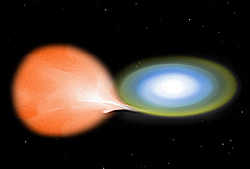
Corona Borealis is a small constellation in the Northern Celestial Hemisphere. It is one of the 48 constellations listed by the 2nd-century astronomer Ptolemy, and remains one of the 88 modern constellations. Its brightest stars form a semicircular arc. Its Latin name, inspired by its shape, means "northern crown". In classical mythology Corona Borealis generally represented the crown given by the god Dionysus to the Cretan princess Ariadne and set by him in the heavens. Other cultures likened the pattern to a circle of elders, an eagle's nest, a bear's den, or even a smokehole. Ptolemy also listed a southern counterpart, Corona Australis, with a similar pattern.

R Coronae Borealis is a peculiar low-mass yellow supergiant star in the constellation of Corona Borealis. It is the prototype of the rare RCB class of variable stars, which fade by several magnitudes at irregular intervals. R Coronae Borealis itself normally shines at approximately magnitude 6, just about visible to the naked eye, but at intervals of several months to many years fades to as faint as 15th magnitude. Over successive months it then gradually returns to its normal brightness, giving it the nickname "reverse nova".

Alpha Coronae Borealis, also named Alphecca, is an eclipsing binary star in the constellation of Corona Borealis. It is located about 75 light years from the Sun and contains two main sequence stars, one class A and one class G.
The Bakersfield Blaze was a minor league baseball team in Bakersfield, California, that played in the Class A – Advanced California League. They played their home games at Sam Lynn Ballpark. Opened in 1941, the stadium is well known for facing the setting sun and its shallow 354-foot center field fence, and seats 3,500 fans.

Musca Borealis was a constellation, now discarded, located between the constellations of Aries and Perseus. It was originally called Apes by Petrus Plancius when he created it in 1612. It was made up of a small group of stars, now called 33 Arietis, 35 Arietis, 39 Arietis, and 41 Arietis, in the north of the constellation of Aries.
Ronald Wayne Shelton is an American film director and screenwriter and former minor league baseball infielder. Shelton is known for the many films he has made about sports. His 1988 film Bull Durham, based in-part off his own baseball experiences, earned him an Academy Award nomination for Best Original Screenplay.

Beta Coronae Borealis is a binary star in the constellation of Corona Borealis. It appears to the naked eye to be a single star and is the second-brightest star in its constellation with an apparent visual magnitude varying between 3.65 and 3.72. Based on parallax measurements taken during the Hipparcos mission, it is approximately 112 light-years from the Sun.

Trientalis borealis, synonym Lysimachia borealis, also known as the starflower, is a North American woodland perennial that blooms between May and June. Starflowers are creeping rhizomes with 8 inch (20 cm) vertical stalks. Each stalk has a whorl of 5-9 lanceolate leaves at its tip, with one or two white flowers on smaller stalks extending from the center of the whorl. The flowers are about 0.5 inches (11 mm) across and consist of five to nine petals that form a star-like shape.

An R Coronae Borealis variable is an eruptive variable star that varies in luminosity in two modes, one low amplitude pulsation, and one irregular, unpredictably-sudden fading by 1 to 9 magnitudes. The prototype star R Coronae Borealis was discovered by the English amateur astronomer Edward Pigott in 1795, who first observed the enigmatic fadings of the star. Only about 150 RCB stars are currently known in our Galaxy while up to 1000 were expected, making this class a very rare kind of star.

S Coronae Borealis is a Mira variable star in the constellation Corona Borealis. Its apparent magnitude varies between 5.8 and 14.1, with a period of 360 days—just under a year. Within the constellation, it lies to the west of Theta Coronae Borealis, and around 1 degree southeast of the eclipsing binary star U Coronae Borealis.

Aurora Borealis is a proposed European research icebreaker, comparable to the world's strongest icebreakers, planned jointly by a consortium of fifteen participant organizations and companies from ten European nations. If built, she would be the largest icebreaker ever built as well as the first icebreaker built to the highest IACS ice class, Polar Class 1.
RR Coronae Borealis is a M3-type semiregular variable star located in the constellation Corona Borealis with a parallax of 2.93mas being a distance of 341 parsecs (1,110 ly). It varies between magnitudes 7.3 and 8.2 over 60.8 days. Located around 1228 light-years distant, it shines with a luminosity approximately 2180 times that of the Sun and has a surface temperature of 3309 K.
Theta Coronae Borealis, Latinized from θ Coronae Borealis, is a binary star system in the constellation Corona Borealis. It shines with a combined apparent visual magnitude of 4.13. There are two components: Theta Coronae Borealis A is of apparent magnitude 4.16, while Theta Coronae Borealis B lies around 1 arcsecond distant and has an apparent magnitude of 6.29. The system is located around 375 light-years from Earth, as estimated from its parallax of 8.69 milliarcseconds. It is estimated to be 85 million years old, with the primary star expected to remain on the main sequence burning its core hydrogen for another 75 million years and the secondary around 500 million years. Both stars will cool and expand once their core hydrogen is exhausted, becoming red giants.

V Coronae Borealis is a Mira-type long period variable star and carbon star in the constellation Corona Borealis. Its apparent magnitude varies between 6.9 and 12.6 over a period of 357 days

Tomi Lahren is an American conservative political commentator and former television host. She hosted Tomi on TheBlaze, where she gained notice for her short video segments called "final thoughts", in which she frequently criticized liberal politics. Many of her videos went viral, with The New York Times describing her as a "rising media star."
W Coronae Borealis is a Mira-type long period variable star in the constellation Corona Borealis. Its apparent magnitude varies between 7.8 and 14.3 over a period of 238 days.
U Coronae Borealis is an Algol-type eclipsing binary star system in the constellation Corona Borealis. Its apparent magnitude varies between 7.66 and 8.79 over a period of 3.45 days The component stars are a blue-white main sequence star of spectral type B6V and a cooler yellow-white subgiant star of spectral type F8III-IV.
RS Coronae Borealis is a semiregular variable star located in the constellation Corona Borealis with a parallax of 2.93mas being a distance of 341 parsecs (1,110 ly). It varies between magnitudes 8.7 to 11.6 over 332 days. It is unusual in that it is a red star with a high proper motion. Located around 1072 light-years distant, it shines with a luminosity approximately 1839 times that of the Sun and has a surface temperature of 3340 K.











